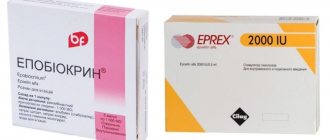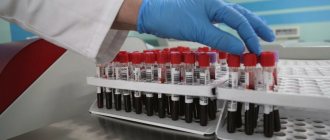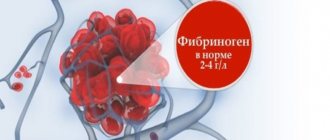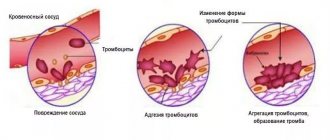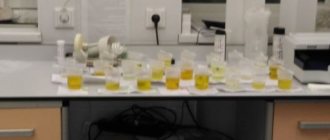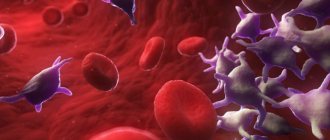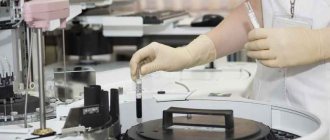To obtain primary information about how the internal organs and systems of the body function, blood is taken and analyzed.
Diagnostics of the components of this life-giving fluid reveals the level of hemoglobin, ESR, the ratio of various groups of leukocytes and all other parameters. Among them is the number of platelets, presented in the analysis form as PLT (Platelets). These cells are essential in the process of blood clotting. They help prevent its significant loss if for some reason the blood vessels rupture.
Functions of platelets in the male body
In cases of disruption of the integrity of a blood vessel, platelets located near the site of damage change shape. Processes begin to extend from their bodies, through which they stick to the site of the lesion, at the same time sticking to each other and increasing in size. A clot called a thrombus forms. It closes the damage to the vessel and stops blood loss.
This is the main and most important function of platelets. Thanks to their ability to form a blood clot that stops bleeding, they got their name. In addition, platelets are endowed with the ability to restore tissue and vessel walls that have been damaged.
Functions of platelets in the male body
This is an additional function of platelets, based on the release of active substances from their composition during their own death. The released substances nourish nearby tissues and vessel walls, helping them to heal quickly. What happens is explained by the stimulation of cell growth and division.
When the damaged tissues and vessel walls are restored, the blood clot, which has fulfilled its protective and healing functions, is dissolved by the same platelets. This is another function of these cells: maintaining the composition of the blood in liquid form. Platelets are endowed with another functional property.
Moving freely through the bloodstream and detecting foreign cells of pathogenic microflora in it, they are activated, taking the shape of a sac.
In this state, platelets absorb harmful organisms, destroying their membrane. In the course of evolution, it turned out that there are more platelets in the male body than in the female body. This is explained by the characteristics of the male body, which in its physiology is designed to perform labor-intensive and dangerous tasks. For this reason, men are more susceptible to injury.
In the course of performing their functions, platelets die in large quantities. Their own life potential is limited to 10 days. The body has to constantly replenish the number of platelets, since without them its own existence is impossible.
Physiological properties
Platelets play an important role in physiological processes. They perform the following functions:
- Primary stop of bleeding.
- Maintaining vascular tone and permeability.
- Defensive reactions.
- Together with leukocytes, they are involved in eliminating inflammatory processes.
- Maintaining blood in a liquid state.
But their hemostatic function is most pronounced. When a blood vessel is damaged, its lumen reflexively narrows. Platelets interact with collagen (they stick together) and a blood clot is formed, which helps stop bleeding.
How and under what conditions are platelets produced?
The process of renewal of blood cells occurs in the body constantly. Some cells die, having completed their functional task, others disintegrate, having served their allotted lifespan. The breakdown products are sent through the bloodstream to the liver, where the metabolic process occurs.
Liver cells synthesize special proteins in platelets that affect the elimination of blood clots that have completed their task and ensure the liquid state of the blood. The process of platelet formation itself occurs in the bone marrow. It goes in several stages.
How and under what conditions are platelets produced?
Initially, a stem cell called a megakaryoblast, 20 microns in size, with a nucleus, is modified, turning into an intermediate cell - a promegakaryocyte. This derivative cell is twice as large as its predecessor, the stem cell. Its nucleus is round, huge, with brightly marked segments that have their own nucleoli.
Next, a megakaryocyte appears. The size of this cell reaches 120 microns; it is the largest cell in the bone marrow with an unusual nucleus of a peculiar shape. Its cytoplasm occupies a significant part of the intracellular space and is granular.
At the last stage, megakaryocytes put forward cytoplasmic processes that pass through bone marrow structures, which are filter barriers, and turn into ribbons - proplatelets. A megakaryocyte has 6-8 such ribbons. While the ribbons are in the filter, the cytoplasm begins to contract, the ribbons break and up to 1000 platelets are formed from each.
All stages of the process can be called the maturation of the cytoplasm, from which the platelet appeared. The megakaryocyte cell is rightfully considered the founder of hematopoiesis. However, this is not the end of the process. Part of the tapes - proplatelets - enters the bloodstream along with platelets, reaches the lungs and 7-17% of the remaining platelets are formed in the pulmonary veins.
One megakaryocyte creates up to 8 thousand platelets, one third of which are sent to the spleen for storage. The rest move in the bloodstream until they grow old or are not needed to perform their functions. The main condition for hematopoiesis is the need for platelets.
This can be either blood loss or illness. To ensure its normal functioning, the body maintains a certain rate of platelets in the blood. Platelets: the norm in men by age, differs from the same cells in women and children. For a healthy man, the norm is from 180 to 400x109/l, an indicator of the amount per liter of blood.
Where are they formed and destroyed?
Platelets are formed from large megakaryocyte cells, which are almost entirely filled with cytoplasm.
These are red bone marrow giant cells. Approximately 70 thousand new blood platelets - platelets - are formed in the body per day. Small fragments of the cytoplasm of megakaryocytes are separated and enter the bloodstream - platelets are formed. One megakaryocyte can produce up to 8 thousand platelets. A special hormone, thrombopoietin, which is synthesized in the liver, kidneys, and skeletal muscles, is responsible for the development of these bone marrow cells in the body. From there, it enters the red bone marrow through the bloodstream. And there it regulates the process of formation of megakaryocytes and platelets. With an increase in platelets in the blood, the synthesis of the hormone thrombopoietin is inhibited.
Normal indicator table for men
The number of platelets in the blood is measured in billions per liter, reflected in documents with the symbol x109 /l. In men, the normal platelet rate changes with age, this is how it is reflected in the table with minimum and maximum values.
| Of the year | Platelet count in x109/l | |
| minimum | maximum | |
| 13 – 15 | 160 | 390 |
| 16 – 25 | 180 | 380 |
| 26 – 35 | 180 | 400 |
| 36 – 60 | 180 | 340 |
| 60 and more | 180 | 320 |
Changes in the minimum indicator, after 16 years it increases to 180 and does not change. The maximum normal value is subject to change. Platelets are normal, in men aged 60 years and older they stabilize at 320x109/l.
What does an elevated platelet count indicate?
These include
- frequent vomiting;
- frequent diarrhea;
- low amount of fluid drunk;
- infections.
To identify the cause, the doctor may prescribe coagulation, ultrasound, bacterial culture and other examination methods that will help determine what exactly caused the increase in platelets.
In rare cases, platelet clumping may occur during pregnancy. This state is called aggregation. When the normal level of adhesive platelets increases, blood clots can form in organs, in the placenta. When aggregation decreases, microbleeding may occur in different areas.
Due to improper nutrition, platelets may decrease; the norm in women by age (the table is presented in the article) should be monitored from puberty. From now on, you should include foods rich in iodine and iron in your diet. They will help avoid the occurrence of thyroid diseases and anemia, which lead to impaired platelet levels.
- Oncological processes.
- Myelofibosis.
- Chronic inflammatory processes.
- Infectious diseases.
- Postoperative period.
- Erythromia (chronic leukemia).
- After removal of the spleen (splenectomy).
- For iron deficiency anemia.
- As a result of long-term use of certain medications, such as corticosteroids.
All these conditions can cause an increase in an indicator such as platelets. The norm in men's blood is usually slightly higher than in women and children. A slight increase in platelets is possible after intense physical activity. This is not a pathology. After rest, this indicator returns to normal. Thrombocytosis can be primary or secondary.
The reasons for this may be:
- Infectious processes.
- Functional abnormalities of the bone marrow.
- Pregnancy and menstruation in women.
- Anemia of various kinds.
- Leukemia.
- Heredity.
- Harmful effects of heavy metals.
- Alcohol in large quantities.
- Massive bleeding.
- Taking certain medications (such as antibiotics, analgesics, estrogens).
Deviations from normal platelet values in one direction or another require careful examination and treatment not only with medications, but also with an appropriate diet.
Symptoms of an elevated platelet count
Deviations from the established norms of platelet counts in the blood indicate the presence of the disease. The human body reacts sharply to such deviations, both in terms of minimum and maximum indicators.
Norm of platelets in men by age
An increased level of platelets in the blood is characterized by the following symptoms:
- sudden dizziness;
- feeling of overwork and exhaustion;
- sudden loss of sleep;
- numbness and loss of sensation in fingers and toes;
- swelling of the foot pads;
- pain and night cramps in the legs of the calves;
- vision problems, sudden appearance of darkness in the eyes;
- itchy skin of the lower extremities;
- pain in the liver area.
Symptoms indicate an imbalance in many body systems and should not be ignored. A visit to the doctor in such cases is mandatory.
Symptoms of a low platelet count
A decrease in the number of platelets in the blood also does not go away without leaving a trace and is expressed in the following symptoms:
- bleeding from the nose;
- the presence of hematomas and their rapid appearance;
- the appearance of blood on the gums when brushing your teeth;
- difficulties in long-term bleeding control in minor injuries;
- pale skin;
- manifestation of hypotension;
- increased heart rate with weak pulse.
If these symptoms were not a consequence of previous blood loss, then this is a likelihood of a disease that requires examination and diagnosis. It is vitally important to establish the reason for this behavior of the body.
How to normalize the level?
To increase platelet levels, you need to determine the cause of the pathological condition. After determining the etiology, it is necessary to act on it. If this principle is neglected, the therapy will be symptomatic and after its cessation the level will decrease again. In addition to treating the disease, you can take the following measures:
- eat right - exclude spicy, salty, alcoholic products, smoked foods, add green vegetables, nuts, meat and fish;
- exclude drugs that reduce platelets;
- take vitamins A, B and C;
- reduce the impact of stress and bad habits;
- reduce physical activity that carries a high risk of injury.
To reduce the indicator you need:
- take antiplatelet drugs - Aspirin, Thromboass, Clopidogrel, etc.;
- maintain a drinking regime - drink at least 2 liters of water daily;
- add green tea, citrus fruits, ginger, beets, grapes, tomatoes, olive and flaxseed oil to your diet.
Reasons for low platelet count
Platelets (the minimum norm in men by age remains unchanged) can decrease for many reasons, but the main ones are recognized as: slowing down the maturation process in the bone marrow, decreasing concentration in the bloodstream, accelerating destruction.
Reasons for low platelet count
A condition in which the amount is below 150x109/l is called thrombocytopenia in medicine. It can develop quickly, while your health worsens, and your symptoms intensify. Slow development up to six months is also possible, then the disease becomes chronic.
Blood science divides thrombocytopenia into groups, highlighting the following:
- hereditary – received from parents, associated with genetic changes in organs involved in hematopoiesis and damage to the platelets themselves;
- destruction - the most numerous group, platelet deficiency is caused by their fragility, less than the established lifespan, and healthy hematopoietic organs, not having time to close this deficiency, are depleted;
- autoimmune – associated with diseases of the immune system (including AIDS), in which antibodies are produced that damage platelets, reducing their number in the blood;
- viral – in which the death of platelets, which do not have time to resist the activity of pathogenic microflora, is accelerated, and the protective functions of the body are weakened;
- productive - characterized by diseases of the bone marrow, including such dangerous ones as leukemia, and also diseases resulting from poisoning with heavy metals, alcohol, radiation damage, anemia;
- consumption – dangerous and rare diseases that provoke platelet activity, leading to the formation of blood clots in the arteries;
- redistribution - the result of a disease of the spleen and its enlargement, as a result, more than a third of the number of platelets is localized there, a sharp drop in platelets in the bloodstream;
- allergic – associated with the consequences of chemotherapy, long-term use of potent drugs.
Etiology
Blood plates are formed from megakaryocytes, large blood elements of the red bone marrow, which are mostly composed of cytoplasm. About 70,000 blood platelets are formed during the day. Small elements of the cytoplasm are separated from megakaryocytes, then enter the bloodstream - this is how PLTs appear. These cells are responsible for essential functions of the entire body. A distinctive feature of platelets is their ability to attach to each other or to certain pathogenic microorganisms. The ripening period for PLT is about 8 days. There are plates that form up to 11 days.
One megakaryocyte is capable of forming up to 8000 PLT. The hormone thrombopoietin is responsible for their proper formation and development. It is a protein produced primarily by the liver. It enters the bone marrow along with the bloodstream, where it is involved in the production of PLT. An increase in the number of platelets in the bloodstream causes inhibition of thrombopoietin.
Note!
The platelet level is included in the general blood test, along with other basic indicators.
Men have normal blood platelet levels of up to 400 billion/l. The normal amount of PLT also changes with age. The children's circulatory system is not yet completely stable; the blood platelets in infants, along with other blood cells, quickly develop and die. Therefore, in children under one year of age, the coverage of the PLT norm is extensive - from 100 to 420 x 109 billion / l.
The level of PLT in the body varies slightly daily. Such fluctuations are not pathological. It may be affected by seasonal variations. Platelets are very important for physiology. They carry out the following activities:
- Primary prevention of bleeding.
- Support of vascular tone.
- Protective and enclosing reactions.
- PLT and leukocytes are involved in preventing inflammation.
- Improved blood flow.
The hemostatic role of platelets is most clearly expressed. When a blood vessel is damaged, it reflexively narrows. The PLT then sticks to the collagen, forming a blood clot that stops the bleeding.
Reasons for increased platelet counts
Platelets (the norm in men aged 26-35 years is the highest 400x109/l) above the norm can appear as a result of severe stress. The result is the appearance of special hormones that accelerate the process of platelet maturation in the bone marrow. A sharply increased number of platelets can cause the formation of blood clots, leading to blockage of blood vessels.
A platelet count exceeding the maximum norm is called thrombocytosis. There are two types - primary, in which there are no symptoms, characterized by a sudden increase in platelets in the blood, and secondary - with obvious symptoms of deterioration in well-being.
Causes of thrombocytosis
The causes of thrombocytosis are as follows:
- absence of the spleen due to injury or surgery;
- a viral infection that causes an excess of platelets;
- disease of the hematopoietic organs;
- the appearance of a malignant tumor;
- excessive consumption of foods containing bioactive substances that stimulate platelet production;
- previous surgery;
- iron deficiency in the body.
Whatever the reasons that led to deviations from the norm in blood platelet levels, you should consult a doctor immediately.
Causes and treatment of deviations
A decrease in platelets to 130-150*109/l and below is called thrombocytopenia, and an excess of the upper norm is thrombocytosis. The causes can be physiological and pathological (due to damage to organs and tissues).
Promotion
Not everyone knows why platelets decrease in men, the norm and methods of treatment. The causes of thrombocytosis are:
- Splenectomy. Cells live on average 7-11 days. Their destruction occurs in the spleen. In the absence of this organ, cells accumulate, but their function fades. Splenectomy (removal of the spleen) may be required for spleen rupture, open wounds, thrombocytopenic purpura, cancer, hematological malignancies, cysts, tuberculosis, heart attack and portal hypertension.
- Systemic diseases (rheumatism). Changes in platelets are observed during exacerbation of the disease. Along with thrombocytosis, symptoms of damage to the heart and joints, erythema and subcutaneous nodules are observed. Tests reveal increased C-reactive protein, accelerated ESR, leukocytosis and cardiac dysfunction. Treatment includes the use of corticosteroids (Prednisolone), NSAIDs (Indomethacin, Ibuprofen), immunosuppressants and sanitation of foci of infection.
- Tuberculosis. The basis of therapy is the use of anti-tuberculosis drugs (Ethambutol, Pyrazinamide, Streptomycin, Rifampicin).
- Abscesses. Antibiotics are prescribed and the abscesses are opened and drained. If necessary, infusion therapy is performed.
- Osteomyelitis. The disease is characterized by damage to the bone marrow and destruction of bone tissue. Antibacterial, detoxification and transfusion (transfusion of blood components) therapy is carried out.
- Hemolytic anemia. Along with an increase in platelets, there is an increase in free hemoglobin, the presence of hemoglobin in the urine, a decrease in red blood cells and an increase in reticulocytes. The causes of anemia are intoxication, autoimmune pathology, DIC syndrome, sepsis, hepatitis and infections (malaria, toxoplasmosis). Treatment involves eliminating the etiological factor, using anticoagulants (Heparin, Fraxiparine), folic acid, Prednisolone, potassium supplements and immunosuppressants.
- Iron-deficiency anemia. Characterized by impaired hemoglobin synthesis due to iron deficiency. The reasons are chronic blood loss, malabsorption syndrome, lack of iron in the diet and an increased need for this element. Treatment includes the use of iron supplements, a strict diet (enrichment of the menu with liver, meat and sources of vitamin C). Laboratory signs include increased platelets, decreased hemoglobin and iron, poikilocytosis and microcytosis.
- Malignant neoplasms (cancer). Treatment options include chemotherapy, surgery and radiation.
- Overfatigue (intense physical activity).
- Erythremia (polycythemia vera). A tumor disease from the group of chronic leukemias, characterized by excessive production of red blood cells, platelets and leukocytes, an increase in BCC (circulating blood volume) and an increase in hemoglobin. Platelets are elevated to the initial and erythremic stages. Chemotherapy is carried out (Mileran, Hydroxycarbamide are used), iron deficiency is eliminated and blood flow increases.
- Liver diseases.
- Chronic myeloid leukemia. This is a tumor blood disease in which there is uncontrolled division of blood cells. Tests reveal elevated levels of platelets, white blood cells, decreased alkaline phosphatase, a large percentage of immature cells, and increased LDH. Thrombocytosis is observed in the chronic and accelerated phases. Treatment involves the use of hydroxyurea and alpha-interferon drugs, chemotherapy, and bone marrow transplantation.
- Overweight.
- Injuries.
- Alcohol abuse.
Important information: What do decreased segmented neutrophils and increased lymphocytes indicate in a blood test?
Decline
If there are deviations from the norm of platelets in men towards a lower value, possible reasons may be:
- Systemic lupus erythematosus. Along with a decrease in platelets, symptoms of skin damage in the form of erythema, signs of arthritis and impaired functioning of the heart and kidneys are observed. Tests reveal thrombocytopenia, leukopenia and lymphopenia. Treatment involves stem cell collection, immunosuppression followed by stem cell administration, lifestyle changes, and corticosteroids.
- Nocturnal hemoglobinuria.
- Aplastic anemia. It occurs as a result of aplasia and hypoplasia (underdevelopment) of the red bone marrow. Manifested by anemic and hemorrhagic syndromes. The reasons are: taking myelotoxic medications (cytostatics, anticonvulsants, tranquilizers, antithyroid drugs), viral infections. Treatment includes the use of Cyclosporine Sandoz, bone marrow or stem cell transplantation, and blood transfusion (transfusion of platelets, red blood cells, and white blood cells).
- Disseminated intravascular coagulation syndrome. Characterized by impaired production of coagulation factors. Therapy involves transfusion of blood and plasma components, infusion therapy, and the use of antifibrinolytics (Aminocaproic acid).
- Chronic myeloid leukemia (terminal stage).
- Erythremia (stage of anemia).
- Transfusion of incompatible blood.
- Blockage of a renal vein by a thrombus.
- Irradiation.
- Hemolytic disease of newborns.
- Autoimmune thrombocytopenic purpura.
- Rickettsiosis.
- Genetic mutations.
- Hereditary anomalies (May-Hegglin, Wiskott-Aldrich, Bernard-Soulier).
- Taking Furosemide and Indomethacin.
Thrombocytopenia is often observed in metastatic cancer, acute leukemia, myelofibrosis and megaloblastic anemia.
Indications for platelet testing
Non-thrombocytopenia - a factor of deviation from the minimum norm of platelet count, non-primary thrombocytosis - an indicator of deviation from the maximum norm of platelets, are not yet fully diseases. They can cause serious diseases that require long-term treatment or indicate the emergence and development of such.
Indications for platelet testing
Therefore, they and their symptoms are an indication for platelet testing. Only a consultation with a specialist doctor, therapist or hematologist can help with this. The doctor should be familiar with the existing symptoms and, at the first stage, issue directions for blood and urine tests.
After receiving the results, do not worry too much if the indicators are not within the norm. To get a reliable picture of such an analysis, it must be repeated after 4 days. It should be taken into account what time of day the blood was drawn. Indicators change depending on time.
Table of platelet norms in the blood of women by age
Platelets are an important component of the blood, which is responsible for coagulation during wounds. The norm of platelets in the blood of women should correspond to blood composition tables
With any deviations in this indicator, a woman’s body can begin to develop various dangerous pathologies, which in the later stages are difficult to treat. At what age is it especially important to monitor the platelet count in women, and what symptoms may indicate deviations from normal values?
The first test to determine the platelet count is a complete blood count. For this, the patient needs to donate blood from a finger prick. If abnormalities are detected, the woman needs to undergo an additional test - a coagulogram. For this study, venous blood is needed. This study gives doctors a more accurate picture of the woman’s condition and determines the ratio of all blood components relative to each other.
Today, doctors use the Fonio platelet level determination. This test involves collecting capillary blood. After the test, the blood is mixed with a reagent and the quantitative content of these cells in the blood is determined using a magnifier. Only a professional doctor should decipher the analysis. Today, the table of indicators for this analysis includes the following points:
- PLT in the blood is the quantitative level of platelets. The plt rate depends on the age category and gender of the patient.
- MPV—mean platelet volume.
- PDW—platelet distribution area.
- PCT - thrombocrit level.
What is the norm of platelets in the blood of women? The indicators of these blood cells in the female body may vary depending on the age of the patient. Also, platelet levels can be affected by pregnancy or menstruation. For each patient, the doctor determines the norm individually, taking into account all factors that may affect the results of the analysis. Average normal values for women are:
The level of platelets in the blood is a relatively stable indicator. The lifespan of this cell is from 7 to 10 days. After this period, the platelet is destroyed and disposed of. New cells take its place. If the disposal process is disrupted, platelets accumulate in the blood, which can lead to blood clots. The norm for women may vary slightly depending on age. The doctor should calculate what the norm should be for you, taking into account all third-party factors.
If the production of these cells is disrupted, there is a lack of them in a woman’s blood, which leads to internal bleeding and impaired blood clotting. Both of these deviations can provoke the development of dangerous pathological conditions. In addition, the presence of deviations in the analysis may indicate a pre-existing disease that caused the disorder.
Normal platelet counts for women should be checked in the following cases:
- Liver diseases.
- Diseases of the cardiovascular system.
- Previous heart attack.
- Suffered a stroke.
- Before anticoagulant therapy.
- Menopause.
All women over 30 need to monitor platelet counts once a year. Women over 40 years of age should undergo this test at least 2 times a year.
It is also important to monitor levels after 60 years of age, when levels can increase significantly and there is a high risk of developing heart attacks and strokes. Platelet control is especially important during pregnancy
How is platelet count determined?
There are several methods for platelet counts. One of them is microscopic. It is produced in Goryaev's chamber. The study is carried out both in blood obtained from a finger and from a vein. The only thing is that the blood from the vein must first be stabilized with an anticoagulant, which is a sodium citrate solution.
In this method, 1.98 ml of a 1% ammonium oxalate solution is measured into a test tube and 0.02 ml of blood is added.
The contents are mixed for a couple of minutes, two chambers are filled and placed for 15 minutes to allow platelets to settle in 25 squares. It is calculated using a conventional microscope, then the number x109/l is derived using simple arithmetic operations. Method error ± 6.5%.
Goryaev's camera
Another method of counting is carried out on a hematology analyzer using automation. Automatic counting provides more accurate platelet count results. The error of this method is ± 2-4%.
Preparation and performance of platelet count analysis
Blood sampling for analysis is carried out in the laboratory of the clinic. This is done in the morning before 10 o'clock. The procedure is not complicated and painless. The attending physician determines what blood is required for the test and indicates this in the direction. The blood can be venous or from a finger.
Obtaining reliable results requires preliminary preparation from patients. It is recommended not to eat fried, salty, spicy or smoked foods the day before. Eliminate alcohol and avoid smoking, refrain from taking medications. Before taking blood, you need to get a good night's sleep. The intake is made on an empty stomach.
Interpretation of platelet count analysis results
The primary test for platelet counts is a complete blood count (CBC). It is carried out within 5 working days. During the analysis, indicators are determined not only for platelets, but also for erythrocytes, leukocytes, hemoglobin levels, color indicators, and erythrocyte sedimentation rate. This is necessary to obtain a general picture of the functioning of the body systems and hematopoietic organs.
The results of the analysis are reflected in a special form, where each line reveals the state of the blood according to one or another indicator.
The platelet indicator is reflected in the line as follows: PLT 500 109/L 180-400. The first three capital letters of the Latin alphabet are an abbreviation of the English word Platelet, translated as platelet. Next comes the number determined during the analysis, the number of platelets. And lastly, the minimum and maximum norm for a man by age.
At what platelet count should you consult a doctor?
An indicator of 500x109/l can be considered insignificant; it could also appear due to stress.
This level is reduced by changes in nutrition and the transition to a gentle diet using blood thinning products. If the deviation from the maximum norm increases significantly, and there are symptoms that worsen your general health, you should immediately consult a doctor.
Stroke risk
Otherwise, the process may progress and lead to the formation of blood clots in the vessels, the risk of stroke and heart attack. Deviation from the minimum norm in the direction of decrease entails loss of the blood's ability to clot. There is a danger of bleeding, including internal bleeding, which is visually determined by the state of feces and urine.
This condition is no less dangerous. In such cases, it is necessary to consult a hematologist. He will prescribe additional tests and tests. Based on their results, treatment is determined, and in special cases, hospitalization of the patient in a hospital.
How to bring your platelet count back to normal
Most often, deviations from the norm are not so great. On the recommendation of a doctor, it is possible to do without drug treatment. In cases of low platelet levels, they resort to changes in diet. It is necessary to include in the menu: fresh parsley and dill, bananas, mangoes, pomegranates, chokeberries, walnuts.
Vegetable fats containing Omega-3 unsaturated fatty acids (linseed, olive, mustard oils). Among animal products, give preference to fatty fish (salmon, tuna, trout). Be sure to take vitamin C and mineral supplements.
How to bring your platelet count back to normal
It will be useful to establish a lifestyle, with the obligatory allocation of time for sleep of at least 8 hours, physical education and sports. If platelets are higher than normal, eating garlic daily will help. The substances included in its composition not only thin the blood, but also dissolve small clots.
Drinking regime is important, the water consumption rate is 2-3 liters per day. Its lack in the blood leads to dehydration and constriction of blood vessels, the concentration of elements entering the blood increases. Drinking natural juices from vegetables, fruits and sour berries will have an effect on blood thinning.
Pomegranates, nuts and chokeberries must be excluded from the diet, as well as fatty animal products, smoked and pickled foods, sweets and baked goods. It is necessary to give up alcohol and smoking tobacco, as the most powerful stimulants of increased blood clotting and the formation of blood clots.
Medications
In cases where changes in diet do not produce results and the disease begins to progress, the attending physician prescribes the use of medications. In each case, such a decision is made on the basis of additional research, strictly individually. Self-medication in this case is dangerous.
To increase blood clotting, the ability of which is lost due to a lack of platelets, the following drugs are prescribed:
- Etamsylate is a drug from the group of coagulants, improves blood clotting and increases platelet levels. Available in tablets for oral administration and ampoules for injection intramuscularly or intravenously. The course of treatment with tablets is from a week to two months. The cost of packaging is 50 pcs. 25-33 rub. The course of treatment with injections is from a week to two. The cost of a package of 10 ampoules is 106-125 rubles.
- Fibrinogen - obtained from donor blood, is prescribed for systemic use in cases of massive bleeding. Available in 250-500 ml bottles together with an infusion system with a filter. The drug is dissolved in water for injection and administered via a system into a vein by drip. Use once or as prescribed by a doctor, depending on the symptoms. Price for 250 ml 240-320 rub. and 500ml 550-850 rub.
- Vikasol - in ampoules and tablets. A synthetic analogue of vitamin K. Indirect coagulant, improves the process of clot formation, effective in use. The course of treatment with tablets or injections is 4 days. Repeat if necessary after 4 days. The cost of a package of 20 tablets is 15-25 rubles. of 30 tablets 15-30 rubles.
- Phytamenadione – increases coagulability, taken orally. Available in capsules. Take up to 6 times a day. The course is from 2 to 5 days, sometimes up to 10 or 25 days. The cost of a package of 30 tablets is 3200-3500 rubles.
Tromboass
Blood thinning caused by excess platelets is produced by the following drugs:
- Aspirin is a simple and affordable drug that inhibits platelet activity and destroys them. Available in tablets. Daily dose 75-100 mg. The course of treatment depends on the symptoms, a week or more. The average cost of 500 mg is 225 rubles.
- Thromboass – acts directly on platelets. Available in tablets of 50 and 100 mg. Take 1 tablet daily. Duration is determined by symptoms. If you have varicose veins, until you are cured of this disease. The average price for 28 tablets, 50 and 100 mg is from 42 rubles. up to 63 rubles, for 100 tablets – 125-183 rubles.
- Heparin is a direct anticoagulant, available in 5 ml ampoules. It is used intravenously and subcutaneously by injection. Effective, requires caution in use. The duration of use is determined by symptoms. The average cost of 10 ampoules is 245 rubles. There is a gel/ointment form in tubes from 15 to 100 g. It is used externally 1-3 times a day on the affected areas, the duration of use is strictly as prescribed by the doctor. Cost depending on packaging from 40 to 600 rubles.
- Warfarin inhibits the effect of anticoagulants and prolongs platelet maturation. Available in tablets of 50 and 100 pcs. The dosage is determined based on test results. Duration of use: 5 days and control analysis. The cost of packaging for 100 tablets is 75-100 rubles.
- Clopidogrel - prevents platelets from sticking together, preventing them from forming a clot. Available in film-coated tablets, 14 pcs. packaged. Used internally, 1 pc. once a day. The course is determined by symptoms. Average price 206 rub.
- Trental – reduces excess platelets, improves the patency of small vessels. It is used orally in tablets of 100 and 400 mg for home treatment. In the hospital - injections intravenously or intramuscularly with a dosage of 100 mg. The drug is taken orally 1-2 times a day, injections are also carried out. Duration of use according to symptoms. The cost of tablets 100 mg No. 60 is 550 rubles. Concentrate for solution (100 mg) 0.02/ml, 5 ml No. 5 - 160 rub.
It must be remembered that many drugs have side effects; the best drug can only be recommended by a qualified hematologist, who will also determine the dosage and method of administration.
Traditional methods
Traditional medicine has a solid arsenal of effects used to normalize blood composition.
To reduce the number of platelets and achieve blood thinning, use the following recipes:
- Dried leaves of Galega officinalis are crushed. Insist 1 tsp. in a glass of boiling water and add tbsp. infusion into tea or water. Drink during the day;
- a mixture of fresh garlic, onion, lemon and honey crushed into a pulp in equal parts is consumed in 1 tsp. three times a day;
- tincture prepared from two heads of garlic and 200 g of vodka and infused for a month, taken orally, half a teaspoon. twice a day;
- Grind the ginger root and mix it with cane sugar in equal parts. 2 tbsp. pour a glass of boiling water over the mixture and leave for 15 minutes. and take small sips throughout the day.
Galega officinalis
To increase platelets in the blood, the following recipes are used:
- 5 ml of nettle juice and 50 ml of milk are mixed and taken 3 times a day for three weeks, milk can be replaced with water;
- 10 g of dry nettle is poured into 250 ml of boiling water, brought to a boil and boiled for 5 minutes, then the broth cools for 2 hours, it is filtered and drunk in two doses. Duration of treatment is three weeks;
- A small amount of sugar is added to beet juice, taken according to tbsp. l. several months before eating;
- Pomegranate juice diluted with water 2:1 is taken 100 ml three times a day for a month.
Other methods
In very complex cases, when the cause of a violation of the normal ratio of platelets in the blood is hereditary pathologies or malignant formations, other methods are used. The most common of them are: chemotherapy, radiotherapy, stem cell or cord blood transplantation, bone marrow transplantation.
Such treatment methods are carried out in highly specialized clinics , using modern scientific data in the field of hematology , with a mandatory preliminary study of all possible causes of deviation from the norm.
Deviations from the norm
Platelets are the smallest formed elements of human blood, the main purpose of which is to participate in coagulation during injury.
Platelets were once cells, but during their development in the red bone marrow they lost some of the structures characteristic of cells and are therefore simply called formed elements.
In return, they acquired a large number of enzymes that act on proteins contained in the blood plasma, causing the blood to clot.
The main protein responsible for blood clotting is fibrinogen, which, as a result of a long series of processes triggered by platelets, is converted into fibrin protein, which has a filamentous structure. A microscope clearly shows how fibrin threads form a network, and in almost every node of this network one can see a platelet.
The ability of blood to clot is very important for a person who repeatedly injures himself throughout his life, loses teeth, etc. Before the invention of drugs for hemophilia (non-clotting blood), patients rarely lived beyond 7 years. But the increased ability to form blood clots is dangerous, especially in old age.
A blood test for platelets can be taken in both private and public institutions. This analysis refers to fairly cheap medical procedures (its cost is about 180 rubles, but can vary greatly from clinic to clinic and from region to region).
In public clinics, the test will be done free of charge if you have a referral from a doctor.
Preparing for analysis is simple:
- Do not drink alcoholic beverages 24 hours before donating blood;
- Do not take medications for 3 days before donating blood (if you cannot stop taking them, consult your doctor);
- Do not engage in sports or physical labor for 24 hours before donating blood;
- If you have a wound or burn, postpone the test for 24 hours or more;
- Come for the test in the morning, on an empty stomach.
- In a government clinic, the analysis will be ready in a day; in a private clinic, you can ask for it to be done faster (in half a day or even in one hour).
Normal after 30-40
The norm of platelets in the blood of an adult remains at the level of 180–380 × 10⁹ pieces. At the age of 30-40 years, problems with hematopoiesis occur infrequently, and exceeding the norm may be evidence of a recent injury or burn, and a decrease may be a sign of problems with the bone marrow or a lack of microelements.
In adulthood, the normal number of platelets does not change, only their own properties change. Thus, their aggregation ability (that is, the ability to stick together, forming blood clots) gradually decreases. At the same time, disorders associated with excess platelet counts occur more often than in youth. Nevertheless, the normal platelet count is 180–380 × 10⁹.
After 50-60
The normal number of red blood cells remains the same. The aggregation capacity decreases even more, and the number of hematopoietic disorders increases. However, until the age of 70 there is nothing to worry about: despite the gradual replacement of red bone marrow with adipose tissue, until this age it provides a sufficient number of platelets.
Let's consider how many platelets are found in the blood of men of different ages.
| Age | Platelet concentration (x109/l) |
| Newborns | 100-400 |
| 2 weeks | 150-400 |
| Up to a year | 160-390 |
| Up to 5 years | 150-400 |
| 5-10 | 180-450 |
| 10-15 | 150-450 |
| 15-18 | 180-420 |
| Over 18 | 180-380 |
As you can see, the norms change only in childhood, and as they grow older, the number of plates stabilizes in order to remain so until old age.
The table shows data for untrained men. For those who play sports, the platelet count before the age of 30 or even 40 can reach 400, and this will not be a pathology. This is due to the body’s adaptation to regular training loads.
Men often have an excess of normal platelets. It is especially often observed in young men involved in sports, in mature men who are engaged in physical work, in those whose work activities are stressful, require concentration or are associated with frequent minor injuries (for example, mechanics, military personnel, etc. .).
Of the serious diseases, an increase in platelets occurs with tuberculosis, leukemia and cancer. After recent skin damage, platelets may be elevated from several weeks to several months (depending on the type of damage).
Also, alcoholics, smokers, and obese people may have blood with a high platelet content.
Platelets are below normal in liver cirrhosis, hepatitis and bone marrow diseases. Sometimes a decrease in platelets is caused by alcoholism and leukemia (although much more often these diseases, on the contrary, increase the concentration).
Platelets also decrease in the blood with aging. A noticeable decline begins after age 70, not earlier.
It is believed that a low level of platelets in the blood is an indicator below 100∙109/l, despite the fact that the lower threshold in the above standards often does not coincide with this value.
A condition in the body in which platelets are lower than normal is called thrombocytopenia. Factors of thrombocytopenia can be divided into two groups:
- Infectious diseases.
These include
Pimples that may appear on the lips, nose, and genital area.
- ARVI, acute respiratory infection
- Hepatitis of various groups
- Mononucleosis
An acute viral disease that is transmitted through human saliva, blood and sweat glands.
Violation of the immune state of the body.
In them, body cells are mistaken for pathogens and destroyed as hostile (for example, lupus).
- Oncological diseases
- Gaucher disease
With this congenital pathology, organs that affect the normal functionality of platelets can be depressed.
Blood thinners (such as Aspirin and Heparin) can cause low blood platelets.
- Including blood thinning foods in your diet
Of course, this reason will have a slight effect on the decrease in platelets in the blood, but it also must be taken into account when making a diagnosis. Foods that thin the blood include lemon, garlic, cherries, ginger, onions, etc.
- Non-infectious causes
- Pregnancy;
- Period of menstruation;
At this time, the woman loses a significant amount of blood, which is what causes low platelets.
- Avitaminosis;
- Alcohol consumption;
- Heavy metal intoxication;
- Disruption of the spleen or even its removal.
In addition to the fact that when platelets in the blood decrease, blood viscosity decreases and it becomes more difficult to stop bleeding from an open wound, the real threat to life is the following: the vessels become more fragile, lose their elasticity and internal bleeding may occur.
Thrombocytosis can have two stages, the causes of which are slightly different.
If the primary stage of the disease can be easily corrected with the help of therapy, then secondary thrombocytosis can only be restrained.
Causes
Primary thrombocytosis occurs against the background of hematopoietic dysfunction, in which the bone marrow is not able to produce the number of cells that the body really needs. In turn, the spleen does not have time to process all the dead cells, the concentration of which in the blood increases significantly. This condition
- anemia;
- leukemia;
- myelofibrosis;
- thrombocythemia.
https://www.youtube.com/watch?v=o94ikVJc6L0
Secondary thrombocytosis develops against the background of the active progression of some chronic and inflammatory diseases that can affect the process of hematopoiesis. The most common diseases are:
- rheumatism (especially in old age);
- tuberculosis;
- ulcerative colitis;
- cirrhosis of the liver;
- chronic inflammatory processes of the pelvic organs.
Signs
Primary thrombocytosis may not have clinical manifestations, being determined solely by a general blood test.
With secondary thrombocytosis, there are the main symptoms of the disease that caused an increase in the platelet index, to which is added general weakness of the body and increased sensitivity to any medications.
If a general blood test was done in the laboratory without a referral from a therapist, then you should definitely visit him with the results obtained.
Having collected a primary history, you may have to retake a blood test, as well as undergo additional examination to determine the cause of the increased platelet level.
Treatment
Normalization of platelet levels is possible only when the true cause of the imbalance is established. It is extremely difficult to determine it by external signs, therefore, after conducting a series of additional examinations and searching for the root cause, appropriate treatment is prescribed.
It is impossible to normalize the platelet index on your own at home, since the reason for its increase is not reliably known.
Consequences
In the event that the cause of an increase in platelets in the blood is directly related to bone marrow oncology, cell transplantation remains the only treatment option. This is a very expensive procedure, the effectiveness of which is estimated to be 50/50. If you do not pay attention to the progression of the disease and do not control the number of platelets, this can provoke the formation of thrombi - blood clots that interfere with normal blood flow. Their danger is that at the slightest overload on the body, they easily break away from the walls of blood vessels, ending up in the heart.
This provokes myocardial infarction and rapid death.
Platelets change during pregnancy; the norm is 150-320 thousand/µl. If the number of platelets decreases below 140 thousand/µl, it is necessary to identify the cause. It can be:
- allergic reactions;
- infections (bacterial, viral);
- gestosis;
- blood clotting disorder;
- taking medications.
A low platelet count can be caused by poor nutrition. To determine the cause, pregnant women need to undergo general blood and urine tests, and also donate blood for coagulation. According to indications, an ultrasound examination may be prescribed.
If platelet levels are low during pregnancy, you may be at risk of severe bleeding during labor.
Possible complications
Any disease, if left untreated or untreated, is dangerous due to its complications. And thrombocytopenia is no exception.
Dangerous complications of this disease can be:
- hemorrhages in the retina of the eye, which can lead to loss of vision;
- impaired blood circulation in the vessels of the brain, leading to hemorrhage with possible paralysis;
- internal microbleeding of the intestine, which can lead to death.
Pulmonary embolism
Even more dangerous are the complications that occur with thrombocytosis:
- the most dangerous of all is pulmonary embolism, which causes pulmonary infarction, ending in pulmonary failure and death of the patient;
- venous gangrene, which occurs when the veins of the lower extremities are completely damaged by blood clots, is accompanied by pain that can cause shock;
- damage to the blood vessels of the brain and heart vessels, leading to stroke and heart attack;
- Budd-Chiari syndrome, caused by thrombosis of the hepatic vein, is accompanied by severe abdominal pain;
- renal failure, impaired blood flow from the kidneys.
In men, with age, platelet levels inevitably deviate from the norm, especially after 60 years of age. Most often this is an increase in platelets, the so-called primary thrombocytosis, but a decrease can also appear as a result of previous operations.
Diagnostics
Diagnosis of the disease is based on the clinical picture and laboratory tests.
A complete examination should be carried out:
- conduct a general blood test to detect deviations from the norm of any indicators (especially indicators below normal);
- bone marrow biopsy (since it is in it that platelets are formed, and if it fails, then there is a high probability of thrombocytopenia as a secondary disease);
- Ultrasound examination of the spleen
